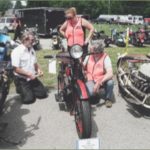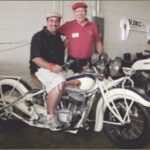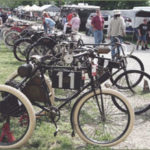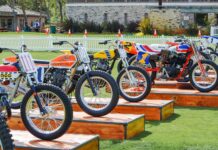Crash course in motohistory
AMCA presents amazing array of antiques
Rhinebeck, N.Y., June 12–14—New York State’s Hudson Valley is rife with historic references. Remember the story of Rip Van Winkle? This is also where the Legend of Sleepy Hollow was born. And then there’s the Rockefeller Estate, Vanderbilt Mansion, Washington Irving’s Sunnyside, Van Cortlandt Manor and a plethora of other historical sites in this area. In fact, this year the Hudson Valley is celebrating the 400th anniversary of Henry Hudson’s “discovery” of the river that bears his name. So it’s not surprising that Rhinebeck, in the heart of the Hudson Valley, was chosen as the location for the AMCA Northeast Coalition’s Grand National Super Meet.
The Dutchess County Fairgrounds is an expansive 188 acres (including parking), and the AMCA meet was spread over maybe 75 of those acres. The setting is quite picturesque, with grassy hills, barns and curvy roads leading to various parts of the property. Food and drink vendors were situated near the main buildings, making snacking a breeze. There was a camping area set aside, however, many exhibitors chose to set up camp near their swap meet display tables, making for a colorful landscape. As enticing as these swap meet displays were, I headed toward Building A that housed the meet headquarters, where I found meet coordinator Tim Talleur who gave me the rundown of the setup and made suggestions of things I might be interested in seeing.
Building A also hosted the booths for each of the six AMCA chapters that make up the Northeast Coalition: the Empire and Hudson Valley chapters from New York State; Big Sandbar, the Long Island, New York, chapter; the Colonial and Seaboard chapters from North and South Jersey, respectively; and the Yankee chapter that serves all of New England. The Museum of Springfield History with its centerpiece Indian Motorcycle collection was there to promote the opening of its new exhibit on Columbus Day later this year.
Under the same roof, major sponsor Walneck’s displayed stacks of their famous Classic Cycle Trader magazine, and I met the delightful Butch Baer, whose dad Fritzie ran the Indian factory dealership and helped start the organization and promotion of motorcycle races in New Hampshire. Butch has carried on the family tradition by becoming an Indian factory racer, and still restores and rides a nice collection of vintage Indians. I also had the pleasure of meeting his grandson Mike, who brought his own 1939 Indian Chief to display. Time and time again at the meet, I saw the passion for vintage bikes passed down through the generations.
Rows of swap meet tables—there were about 600 spots set up—winding around the exhibit halls and even up some of the hillsides took up most of the meet space. Many enthusiasts had swap meet displays, including vintage clubs; vendors selling period clothing, vintage parts, cleaning products and the like; and shops and individuals displaying their restorations and all sorts of other merchandise. In fact, it was like a little motorcycle city with endless mini-parades of folks riding old iron, including scooters, mopeds and pit bikes. (Thanks to Les from Easton, Pennsylvania, who gave me a tour of the fairgrounds in his ’50 Panhead sidecar rig!) Everything you needed was right there, so you didn’t have to leave the fairgrounds all weekend (and many didn’t).
Folks brought their kids and their dogs, as the entire event was very family- friendly. There were activities for the kids like face painting and games, but the coolest family moment I saw was a display near a swap meet setup. Larry Phillip’s parents, who own Phillips & Son, a vintage bike business in Clinton, New Jersey, acquired an old Harley Servi-Car that they lettered with “Larry’s Servi-Soda” to emulate vendors of time past. And Larry really did have liquid refreshments for sale!
The meet had a laid-back vibe, and it was a wonderful opportunity to stop and chat with enthusiasts who had deep knowledge of their particular passions. Every bike had a story, and every owner was pleased to recount tales of intrigue and daring, or the unearthing and restoration of a rare find (or better yet, finding that ancient iron in good enough shape to show without restoring). For instance, I spent some time with Mike “Kiwi” Tomas, who traveled from Riverside, California, to promote his burgeoning business, Kiwi Indian Motorcycle Company that will soon open a branch in Mitchell, South Dakota. I don’t know anyone who knows more about 1953-and-prior Indian Motorcycles than Mike does.
Later that weekend, I met Gary Langton and Jay Berry of J’s Rod & Custom, who had a ’71 Rokon RT340 on display. Rokons were manufactured in Vermont from 1963 through 1978, when the company went into receivership. I watched the guys try to start the Rokon using a method I’d never seen before. First, they tipped the bike over on its side to get gas to flow into the carburetor’s “good side,” primed it using a combination of choke, throttle and brake application, and then pull-started it like a lawn mower. It was quite a spectacle.
Several vintage clubs held their meets within the AMCA Grand National Meet, such as the Vintage Japanese Motorcycle Club, the (Indian Scout) 101 Association, British Iron, a BMW vintage club and I’m sure I missed a few. I struck up a conversation with a guy named Red who told me about the Brough Superior Club that was also holding a meet. He led me way up a hill where there were eight beautiful Broughs glinting in the sunlight. Some of the owners were lounging in camp chairs underneath a tent, and they were happy to educate me about “the best bikes ever made.”
The Brough Superior Club is based in Nottingham, UK, where the bikes were manufactured from 1919 to 1940, and about 1,100 from the 3,000-total-bike production run survived. The guys at this weekend’s meet were all U.S. members, and although there are about 160 Broughs known to be in the U.S., the majority of those in the Northeast were right here. When member Vic Olson paid $7,000 for his Brough 30 years ago, people thought he was crazy. According to Vic, that bike is now worth about a quarter-million dollars. After all, Lawrence of Arabia had seven Brough Superiors, known as George I, George II, and so on, until he was fatally injured in an accident while riding George VII in 1935.
Several complementary activities also took place during the meet, such as an antique truck meet held in the racetrack infield right next to an antique machinery and tractor show. On the other side of the infield, Cody Ives’ globe of death and freestyle jump show performances wowed the crowds. The California Hell Riders displayed their daredevil skills riding inside the wooden barrel of the Wall of Death. In a building across the infield, the Century Museum Village and Collectors Association had exhibits illustrating everyday rural life from 1870-1929. Just down the road, Cole Palen’s Old Rhinebeck Aerodrome staged air shows on Saturday and Sunday, and offered flights over the Hudson Valley in a 1929 New Standard biplane.
The centerpiece of the meet, though, had to be the Motorcycle Timeline spread across a big field behind the exhibit halls. Organized by Steve Barber and introduced at the first Rhinebeck meet in 2007, this year’s timeline displayed over 325 bike models from nearly every year starting with 1974 and working backwards. Ted and Jerry Doering of Tedd’s Cycles, aka VTwin Mfg., another major meet sponsor, owned the oldest bike in the timeline, an 1897 De Dion-Bouton tricycle, for the second year in a row. Other makes of varying degrees of rarity included Cleveland, Simplex, Thor, Marsh, PT, Ace, Ariel, Horex Regina, Flying Merkel, Yale, Ossa, Iver Johnson, Matchless, Sunbeam and, of course, a Brough Superior. As expected, Harley, Indian, Norton, Honda, Yamaha, Kawasaki, Excelsior/Henderson, BMW, Royal Enfield, BSA, Ducati, Triumph, Moto Buzzi, Bultaco, Sears and Vespa were represented, as well.
The AMCA judging, led by chief judge Kevin Valentine, included 116 bikes of which 46 were in the timeline (the other 70 bikes were brought in on Sunday, adding to the outdoor display). National Recognition awards were given to eight AMCA members, including Period Modified first place to Bob “Sprocket” Eckardt for his 1958 H-D FLH, Most Unique to Dave Wasserman for his 1900 DeDion-Bouton, Oldest to Randy Walker for his 1898 PT, and Longest Distance Ridden to Richard Watson Sr. on his 1951 Indian.
The highlight of the AMCA banquet on Saturday night was guest speaker Rod Pink, son of the famous Reggie Pink, an acclaimed racer and owner of a prominent dealership in the Bronx from 1927 until his death in 1962. Reggie Pink H-D relocated to White Plains, New York, later that same year. Rod was a successful racer as well—in fact, the whole family was involved in racing and selling motorcycles—and with the help of the Pink family photo album projected on a screen, brought us back to the olden days of racing and riding.
With an estimated 20,000 in attendance, this year’s meet was the biggest and best yet for the Northeast Coalition. I was so enthralled by the bikes, the camaraderie, and the skill and dedication needed to keep these classic machines in working order that I joined the AMCA on the spot. You don’t have to own a vintage motorcycle; just having a passion for the machines of the good old days is enough. See you next year, and by then, maybe I’ll have an antique of my own to ride! (www.rhinebecknationalmeet.com)
























I was judged at Rhinebeck Grand National 2016 july 3th and photographed with second place award what issue thunder press would this be in or the correct e-mail address for photo,s thanks, Steve
Hi Steve, this is an online only story, never published in print. I will follow up with Shadow to see if she has any pictures for you and reach out to you at your email.
Thank you,
Hannah Kiges
Assistant Marketing Director
hkiges@thunderpress.net
Note: your comment is on our 2009 coverage, here is the 2016 story http://thunderpress.wpengine.com/online-exclusives/amca-rhinebeck-grand-national-meet/2016/07/08.htm
Have dates for 2017 been decided yet ?
It doesn’t appear so, but you can keep checking back at their website: http://www.rhinebecknationalmeet.com